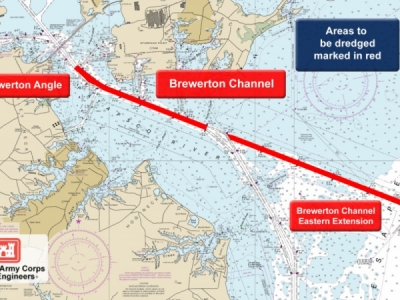
Posted on February 25, 2020
Map shows Brewerton Angle, Brewerton Channel and Brewerton Channel Eastern Extension, are three channels associated with Baltimore Harbor that crews under contract with the U.S. Army Corps of Engineers will be dredging as part of work that began at the end of February 2020. In all, approximately 5.5 million cubic yards of material from six channels associated with the Baltimore Harbor, ensuring continued safe navigation for vessels going in and out of the Port of Baltimore.
BALTIMORE – The U.S. Army Corps of Engineers, Baltimore District, has begun dredging approximately 5.5 million cubic yards of material from six channels associated with the Baltimore Harbor, ensuring continued safe navigation for vessels going in and out of the Port of Baltimore.
“Baltimore Harbor channels rely on maintenance dredging to serve and strengthen the region and the nation, energize the economy, and reduce navigation safety risks,” said Col. John Litz, Baltimore District commander. “Many diverse commodities import and export from the Port of Baltimore on a daily basis, such as specialized cargo and containers that broke records in 2019.”
The amount of material being removed would cover the field at M&T Bank Stadium, goalpost to goalpost, to a height of nearly 2,600 feet, or high enough to stack more than six Baltimore World Trade Centers.
The Corps awarded two contracts worth up to approximately $56.2 million to Great Lakes Dredge and Dock of Oak Brook, Illinois, to conduct maintenance dredging for five Maryland channels and the York Spit Channel in Virginia. Dredging associated with the York Spit Channel contract is tentatively scheduled to begin in May.
The following channels used by large container ships traveling to and from Port of Baltimore facilities will be dredged to their respective authorized dimensions, plus allowable over depth of 1 foot:
— Brewerton Angle (Maryland) to a depth of 51 feet and width of 700 feet (roughly 170,000 cubic yards);
— Brewerton Channel (Maryland) to a depth of 51 feet and width of 700 feet (roughly 305,000 cubic yards);
— Brewerton Channel Eastern Extension (Maryland) 36 feet and width of 600 feet (roughly 950,000 cubic yards);
— Tolchester Channel (Maryland) to a depth of 36 feet and width of 600 feet (roughly 1.2 million cubic yards);
— Northwest Branch East Channel (Maryland) to a depth of 50 feet and width of 700 feet (roughly 160,000 cubic yards);
— York Spit Channel (Virginia) to a depth of 51 feet and width of 800 feet (roughly 2.68 million cubic yards).
The material being removed consists primarily of mud, silt, sand, shell, and mixtures thereof.
In coordination with the State of Maryland, the roughly 2.15 million cubic yards of material dredged from Brewerton Channel Eastern Extension and Tolchester Channel will be beneficially reused at the Paul S. Sarbanes Ecosystem Restoration Project at Poplar Island located on the eastern side of the Chesapeake Bay. Also in coordination with the State of Maryland, the roughly 635,000 cubic yards of material dredged from Brewerton Angle, Brewerton Channel and Northwest Branch East Channel will be placed at the Masonville Dredge Material Containment Facility. In coordination with the State of Maryland and the Commonwealth of Virginia, the roughly 2.68 million cubic yards of material dredged from the York Spit Channel will be placed in the Wolf Trap Alternate Placement Site, Northern Extension.
Maintenance dredging of the Maryland channels is expected to conclude by early summer and the York Spit Channel maintenance dredging is expected to conclude by late summer.
Source: dvidshub.net





